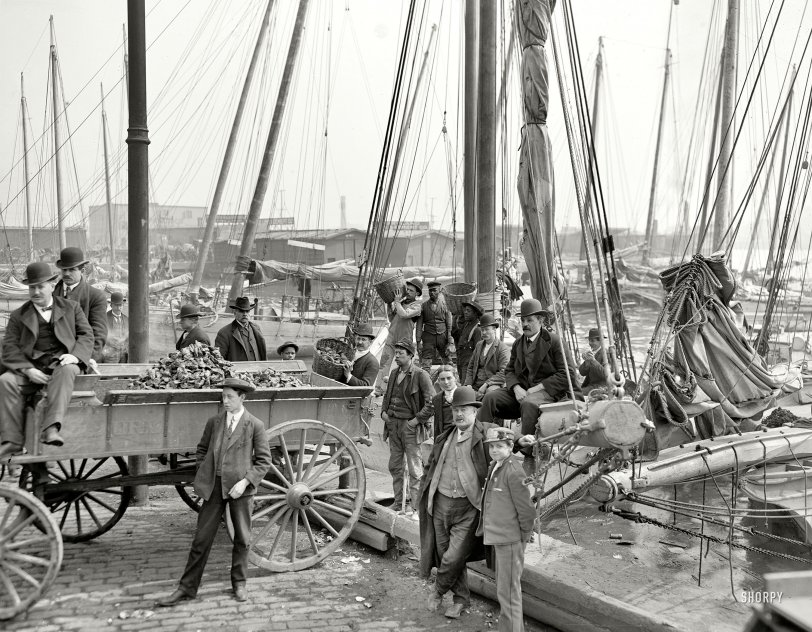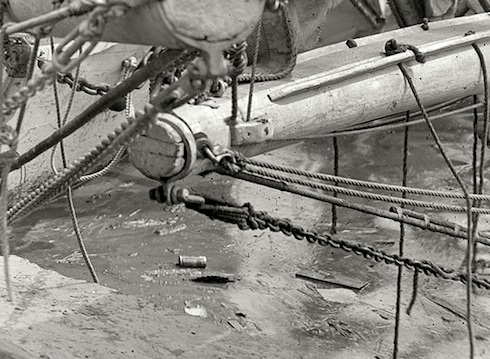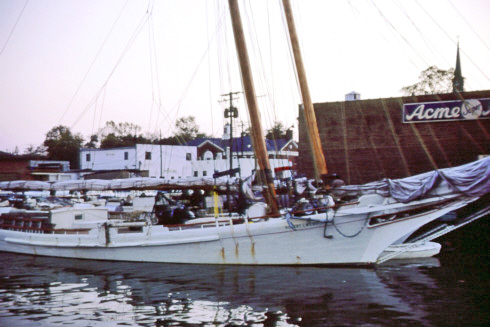


Framed or unframed, desk size to sofa size, printed by us in Arizona and Alabama since 2007. Explore now.
Shorpy is funded by you. Patreon contributors get an ad-free experience.
Learn more.

- Roll your own
- Rugged and real!
- A Charles Purcell - Mama Cass Connection
- Uncle SAAM
- Obfuscation
- One Chocolate Soldier rode away
- Victor Marquis de la Roche
- The Little House Across Way ...
- Vanderbilt Gates
- Vanderbilt Mansion
- You can still see that gate
- Withering heights for me
- So Jim,
- Top Heavy
- Re: Can't Place It.
- Bus ID
- Since you mention it
- The White Pages ?
- Moonlight Tower
- 1907?
- Fire(men) and Water
- Can't Place It
- Can anyone
- Wings
- Where's Claudette and Clark?
- Overbuilt Rolodex
- One song
- Give Me Wings Please!
- PRR
- Pinball Wizards
Printporium
The Oyster Wagon: 1905

Circa 1905. "Unloading oyster luggers at Baltimore." 8x10 inch dry plate glass negative, Detroit Publishing Company. View full size.
Dirty water
I always thought that the water would have been clean, but I daresay, it looked worse then!

A banana and oyster sandwich
In the distance is the USS Constellation moored at Pier One Pratt Street today. This is also the same area where Bananas to Baltimore was featured a while back on these pages.

Skipjacks and Buy Boats
The boats with the masts raked sharply back are skipjacks and bugeys. They would dredge for oysters. Early bugeyes were made from hollowed out logs, like big canoes. The more modern skipjacks appeared late in the 19th century.
Buy boats would go around and buy oysters directly from watermen at work on the bay and bring them into Baltimore and other ports to resell. The boats with the more vertical masts are likely buy boats, called luggers, I suppose, in different locales.
A sharply raked mast is an advantage when pulling a dredge, but otherwise makes for difficult sailing.
Here is a photo of a working skipjack or two that my father took at the Annapolis City Dock in October 1965. The Dock was full of working skipjacks at that time.

Shucks!
What you say when your oyster wagon tips over...
$1 per bushel
Whoever captioned this photo for the Detroit Publishing Co. did not know their boats. While luggers were common in the Gulf Coast oyster fisheries, on the Chesapeake the dredgers sailed in bugeyes, pungies and skipjacks. The location of the photo is Pratt street; in the background is Pier 1 and the Maryland Lime and Cement Co.
Baltimore Sun, January 10, 1903.Many Oysters Brought In
At Least 30,000 Bushels Arrive and More Coming.
Fifty sailing vessels deeply laden with oysters anchored in the harbor Thursday. It is estimated they contain at least 30,000 bushels of oysters, representing a value of $30,000 or more. Another large fleet is reported bound up from the lower bay, and some of the captains who have had experience in such matters said yesterday that a glut may ensue.
Yesterday along the wharves oysters were selling at prices ranging from 80 cents to $1.25 per bushel, according to size, quality and flavor. The demand was not unusually brisk, even for selects, and many captains who arrived early yesterday morning went to bed last night with their cargoes still unsold. Many of the vessels were consigned directly to the packing houses or are running under charter. Many other captains, however, depend solely on the market to dispose of their stock. Among some of these there was a feeling of uneasiness as the fleet continued to grow during the day.
At 4 o'clock yesterday afternoon there were 27 deeply laden oysters freighters in Canton Hollow or tied up along the Canton docks, discharging. At Pratt street, between Bowley's wharf and Light street, 23 loaded craft were tied up waiting to unload. Capt. Allen P. Vane, of the schooner Margaret H. Vane, which arrived Tuesday, said yesterday that he passed a large fleet of loaded oyster boats in the lower bay, bound for this port. They were expected to arrive this morning, as the southwest wind must have brought them hurrying up the bay yesterday afternoon.
The quantity of oysters now in port exceeds by far any previous day's record since the opening of the present season. Most of them are of fair quality from the York, Putuxent and Rappahannock rivers and from the Western Shore of the bay. Some are from Tangier and are very large. Very few are from the Eastern Shore of Maryland. The packing houses there are said to be using all the stock taken in those waters. Practically no oysters are coming from the upper bay and the present season there is said to be a failure. Local packing houses are running with full forces and have no difficulty in securing working stock. The $1.25 quotations yesterday were for select stock from the rocks which can be utilized as barrel stock. The prevailing prices hovered about $1.
Keaton?
I think the guy front center looks like Buster Keaton. He has the right hat anyway.
Also, front right is a telegraph boy. We have seen many pictures of child laborers with the photographer's seeming disapproval. What did telegraph boys grow up to do for work?
Pirates of the Chesapeake???
Back in those days, nighttime rustling of oysters out in the Bay from beds planted by commecial interests was a popular form of illegal enterprise. As a merchant sailor from Michigan, my mother's father, according to stories he told his children, was part of that trade. The oyster policew were hot on his trail by 1890, so he fled north to New York State and became an insurance man and real estate operator...somewhat of a less exciting job. This is a terrific photo.
Wilse
Those were the days,
when oysters were the food of the masses.
Arlo Guthrie?
The guy in the front of the picture looks like a young Arlo Guthrie. I've heard of Alice's Restaurant, but Alice's Oyster Bar?
[I think it's Richard E. Grant. - tterrace]
Bowlerstache
"No man shall wear a bowler hat in public unless he is festooned with moustache." Baltimore Public Ordinance 23 of 1902.
























On Shorpy:
Today’s Top 5